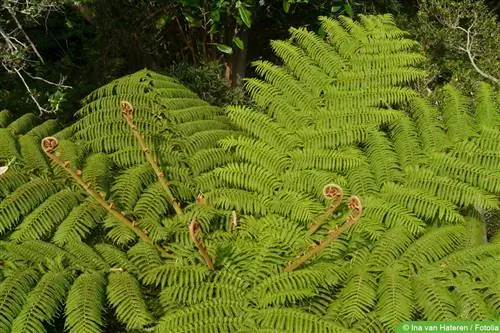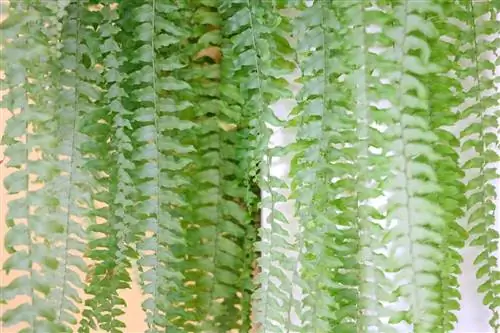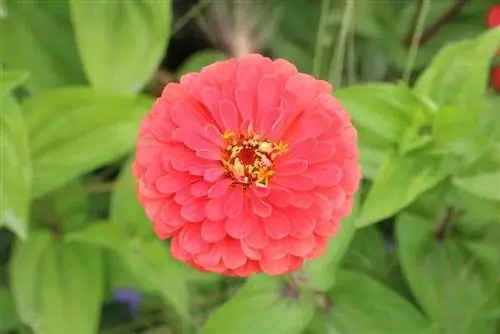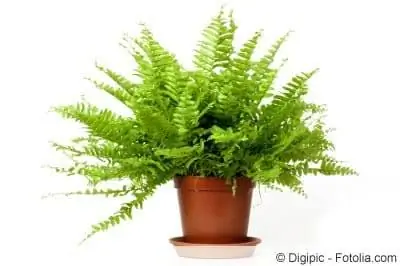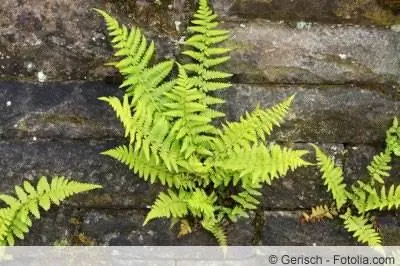- Author admin [email protected].
- Public 2023-12-17 03:39.
- Last modified 2025-01-24 12:45.
These extraordinary creatures are considered to be the oldest and largest ferns in the world and can grow up to 20 meters high in their native tropical and subtropical rainforests. The first tree ferns came to Europe in the 19th century. The living fossils have now found their way into our home gardens and offer fans of ferns the right introduction to the world of exotic plants. However, there are a few basic things to keep in mind when keeping and caring for these tropical beauties.
Profile
- Botanical name: Cyatheales
- Department: Ferns, Vascular Plants
- Genus includes over 620 species
- Use: as a house and container plant
- largest representative: Norfolk tree fern (Cyathea brownii)
- Growth height: up to 30 meters
- Crown diameter: up to five meters
- has a tuft of fern fronds on the trunk
- Location: bright, partially shaded to shady, protected from the wind
- Watering: regularly, do not let it dry out, spray the trunk and fronds
- Fertilizer: Regular liquid fertilizer from April to September
- Wintering: bright, cool room
Appearance
Tree ferns are certainly among the more demanding potted plants for garden enthusiasts. In its original home the trunk reaches an astonishing height of 30 meters - Norfolk tree fern (Cyathea brownii). The impressive crown with a diameter of up to five meters consists of over 50 delicate fronds, which can sometimes be up to four meters long. The trunk grows relatively slowly, at just five centimeters per year. However, its diameter can be 40 centimeters.
The real Cyatheales has a tuft of fern fronds on its straight trunk, which are multi-pinnate. Pure tree fern families are Dicksoniacea and Cyatheaceae, which also have commercial importance. The genus Cyatheales includes over 620 species and is therefore the largest group.
Location
Tree ferns can be easily cultivated as pot or house plants in our latitudes. As a houseplant, the palm-like creatures should have enough space. Additionally, a location near a window would be ideal. If the Cyatheales is too dark, it will grow slower.
As long as the winter garden is not overly hot in summer, it is also suitable for tree ferns. At temperatures above 35 degrees, plant lovers should avoid it. Many species can safely spend the summer outdoors.
- partially shaded to shady place
- sheltered from the wind
- as a houseplant in a bright location
Floor
So that the tree fern can develop its full beauty, the substrate should be optimally tailored to it.
- water permeable
- air permeable
- loose soil with organic matter content
- acid soil
- no limescale
- nutrient-rich
A thick drainage layer should always be placed in the lower part of the pot or bucket - a mixture of gravel, sand, expanded clay, humus-rich garden soil and a small proportion of cattle mulch.
Tip:
Substrates made from coconut fibers offer a successful alternative. Potting soil can also be used if a lot of compost is mixed in.
Pouring
Tree ferns need high humidity and lots of water. There is a special feature of tree ferns when it comes to the roots: when the leaf stalks dry out, a short section remains from which new roots form. These roots not only support the stability of the trunk. The tree fern uses them to absorb nutrients and water. Therefore, it is extremely important to keep the trunk moist as well. This is best achieved if the water is poured into the crown of the leaves. The water running down also supplies the trunk with moisture. Additionally, the trunk can be sprayed with a sprayer. Excess water must be removed.

Fertilize
- Fertilizing time April to September
- Regularly add some liquid fertilizer to the irrigation water
- Use green plant fertilizer with little phosphorus
- Pour fertilizer water into leaf crown
Wintering
Although some species of Cyatheales would survive short periods of frost, tree ferns should not be overwintered outdoors. They are better off in a bright and less heated place. A cold house or a shady place in the winter garden would be ideal.
- Wintering at five to ten degrees
- water moderately, do not let it dry out
- does not tolerate winter sun
Hobby gardeners who grow their tree ferns outdoors year-round can take steps to protect their exotic friend:
- A place protected from the wind without direct sunlight
- Place the bucket on a surface such as Styrofoam plate
- Layer of bark mulch on the ground and in the leaf crown
- Tie the crown with string
- Wrap trunk with fleece or straw mats
- Pot wrapped in foil or Styrofoam
- water moderately
Varieties
Cyathea australis (Australian tree fern)
- Giant from the tree fern family
- Trunk height over ten meters
- Canopy can reach a diameter of five meters
- dark brown to black trunk
- Palm fronds are bright and rich green
- relatively cold tolerant
- can tolerate short-term frost down to minus ten degrees
- can be cultivated as a pot and house plant
Cyathea cooperi (Scale tree fern)
- popular indoor tree fern species
- fast growing
- Growth height over ten meters
- Fern fronds can reach lengths of more than three meters
- Trunk at around 20 centimeters, significantly narrower than other species
- must not be shortened, otherwise it will die
- black tribe
- Fern fronds green and shiny silver in the light
- can stand outside at temperatures down to zero degrees
Cyathea dealbata (New Zealand silver fern)
- robust potted plant
- Trunk height over ten meters
- Canopy roof up to six meters
- Fern fronds shine silver on the underside
- Trunk is slender and brown-black
- Older specimens can tolerate minus five degrees for a short time in winter
Cyathea medullaris (Black Tree Fern)
- Room cultivation possible all year round
- Growth height up to 20 meters
- Canopy roof up to three meters
- Fern fronds reach five to six meters in length
- not frost resistant
Cyathea smithii (soft tree fern)
- to be cultivated as a container plant
- Trunk height up to eight meters
- growing slowly
- Fern fronds reach a length of 2.5 meters
- frost-hardy tree fern
- sensitive to heat
- fully shaded location
- can tolerate short-term frosts down to minus ten degrees
Cyathea tomentosissima
- keep outside in summer
- can also be cultivated as a houseplant all year round
- growing slowly
- Growth height up to eight meters
- Fern fronds have delicate red scales
- can tolerate light frosts down to minus three degrees
Cyathea brownii (Norfolk tree fern)
- Container plant or as a houseplant in the winter garden
- growing fast
- thin trunk
- forms fronds up to five meters long
- feathery fern fronds made of deep green leaves
- Base is covered with dark brown scales
Frequently asked questions
My tree fern lost all its leaves in winter. Now it's sprouting again, but it's getting brown tips again. Why is that?
Since the tree fern is originally native to tropical and subtropical areas, it is likely to lack humidity. The dry heating air in winter means that the tree fern does not feel comfortable. Spraying the trunk daily already helps.
I have a tree fern in a pot on the balcony. Now a brown coating forms around the fern, which looks somewhat moldy. It “steams” when pouring. What to do?
It could be a slime mold that initially looks yellow and turns brown when dried out. This fungus occurs when the proportion of peat in the substrate is too high. When touched (or by watering), the mushroom releases countless spores that look like fine smoke. Simply remove superficially. It does not harm the plant.

